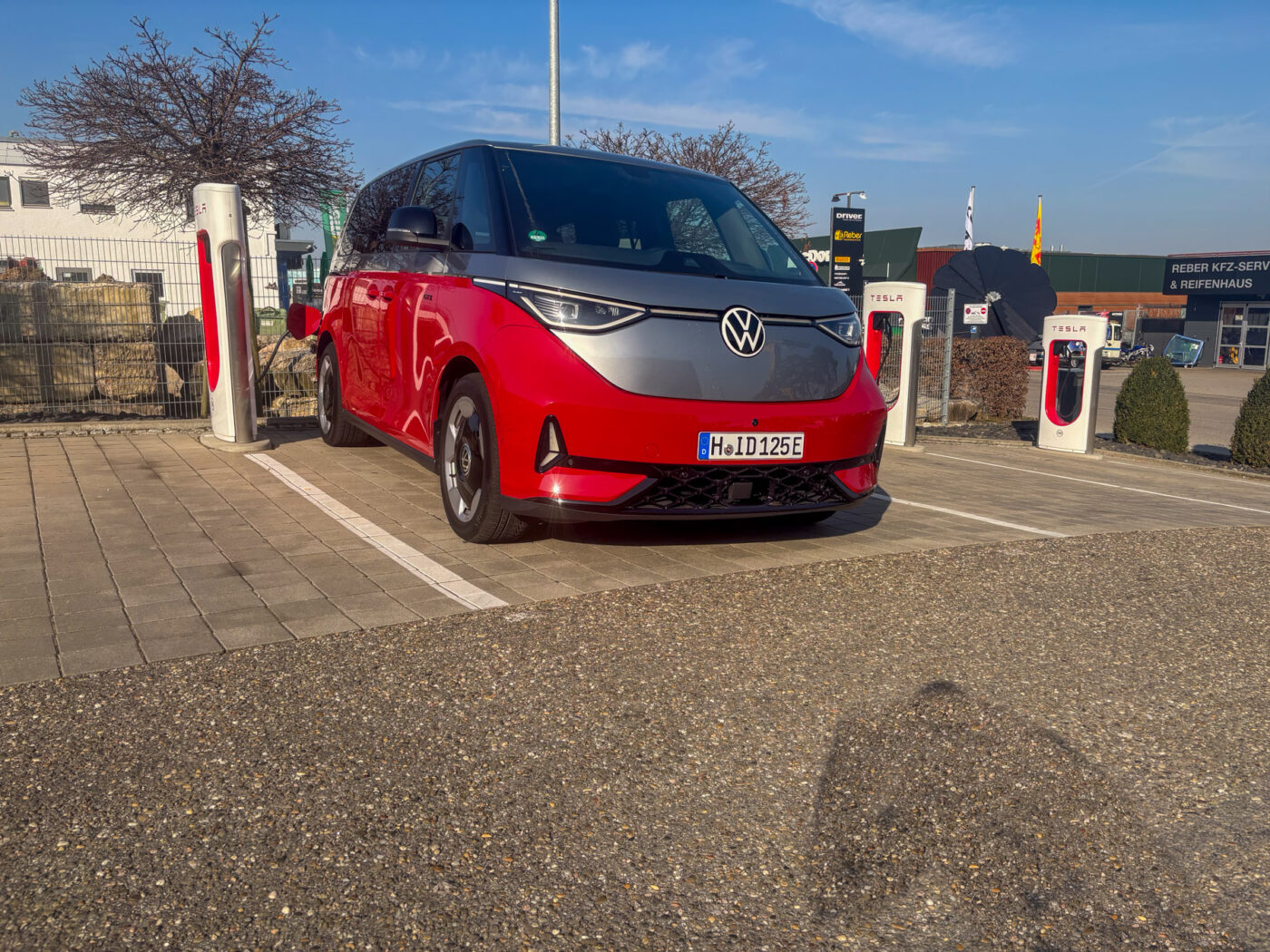
VW ID. Buzz GTX: Between sense and nonsense
There’s no question that hardly any of our recent test cars have received as much positive feedback from passers-by as the ID. Buzz GTX. I am now well-known for getting many test cars in my neighbourhood, but my neighbours did approach me about this vehicle more than usual. Even metallic green Porsches or the BMW iX5 Hydrogen with its eye-catching foiling attracted less attention than the VW bus in the red and silver two-tone paintwork with the 20-inch rims in retro design. Even in the supermarket car park, the ID. Buzz GTX got people looking.
At its core, it is a practical family van, not an exotic sports car. Although the ID. Buzz also has certain sporting ambitions, as the test vehicle is the dynamic GTX model. This not only offers a 79 kWh battery, but also a 250 kW all-wheel drive. In a van.
For our test, VW Commercial Vehicles provided the standard body with the ‘short’ wheelbase of 2.99 metres. With the premiere of the GTX, the ID. Buzz is also available with a 3.24 metre wheelbase in the long version. The model then not only offers an 86 kWh battery for up to 475 WLTP kilometres, but also up to seven seats for the first time. The long version measures 4.96 metres in total and has actually only grown between the axles – the front and rear overhangs are exactly the same.
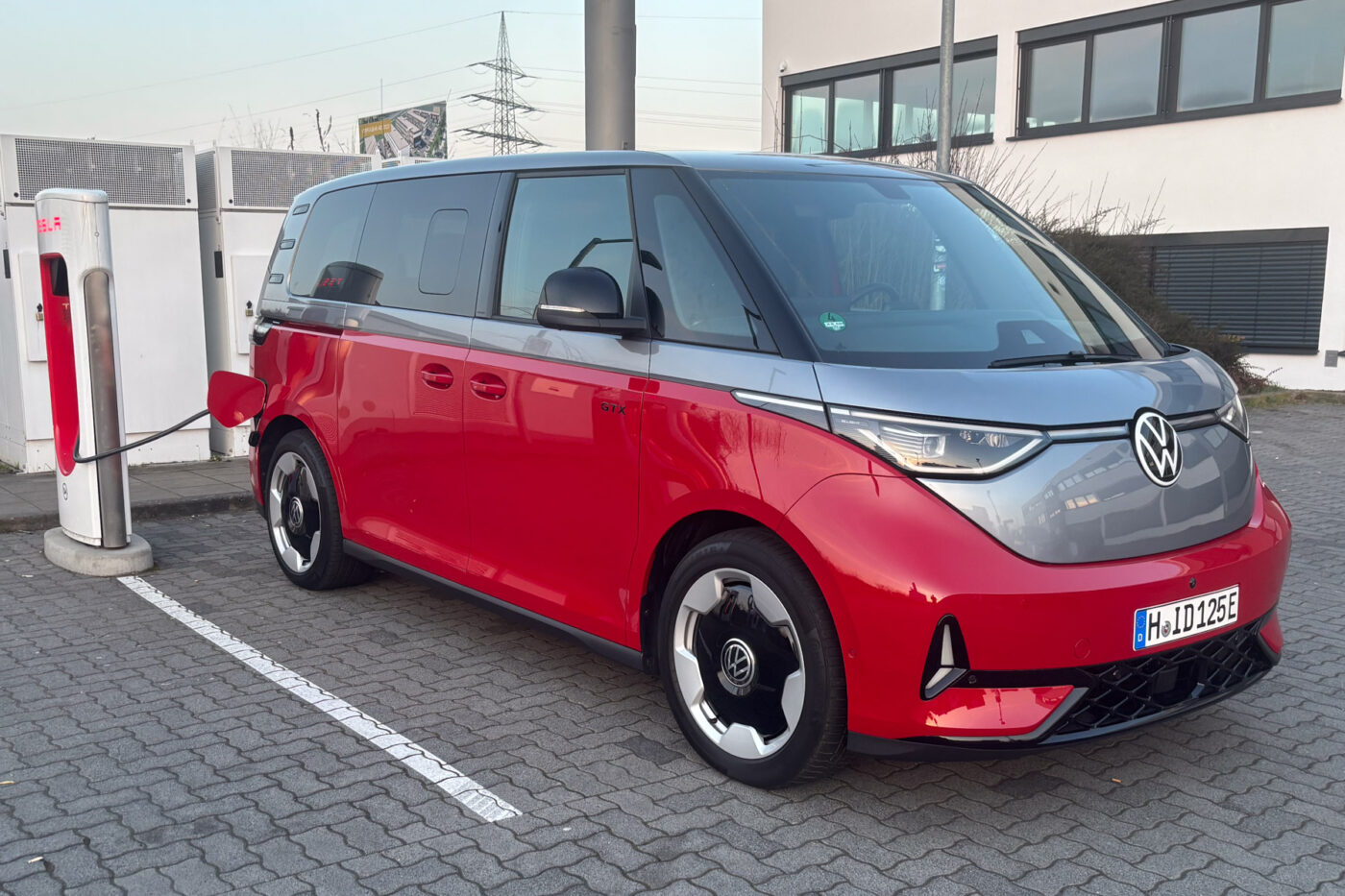
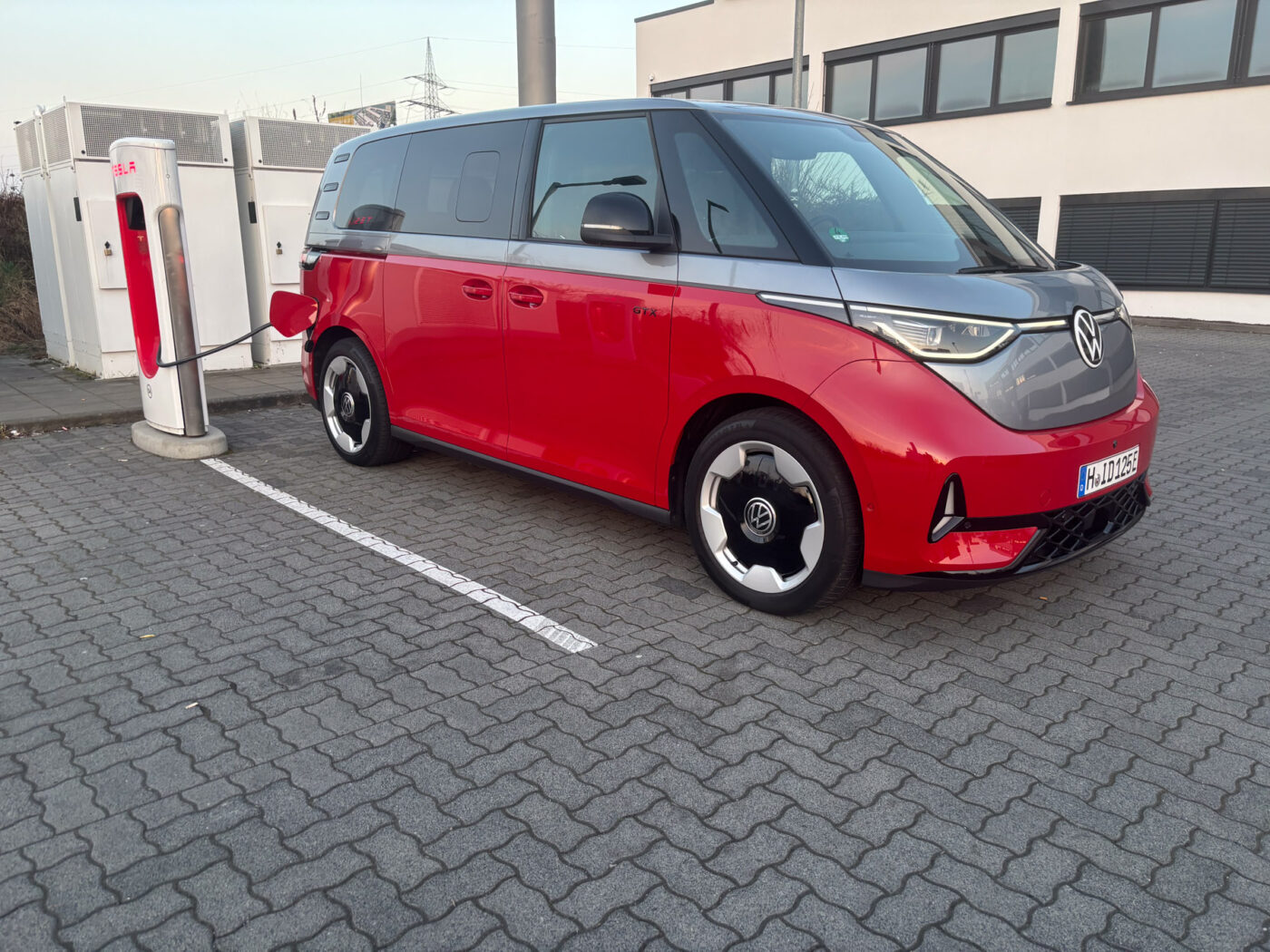
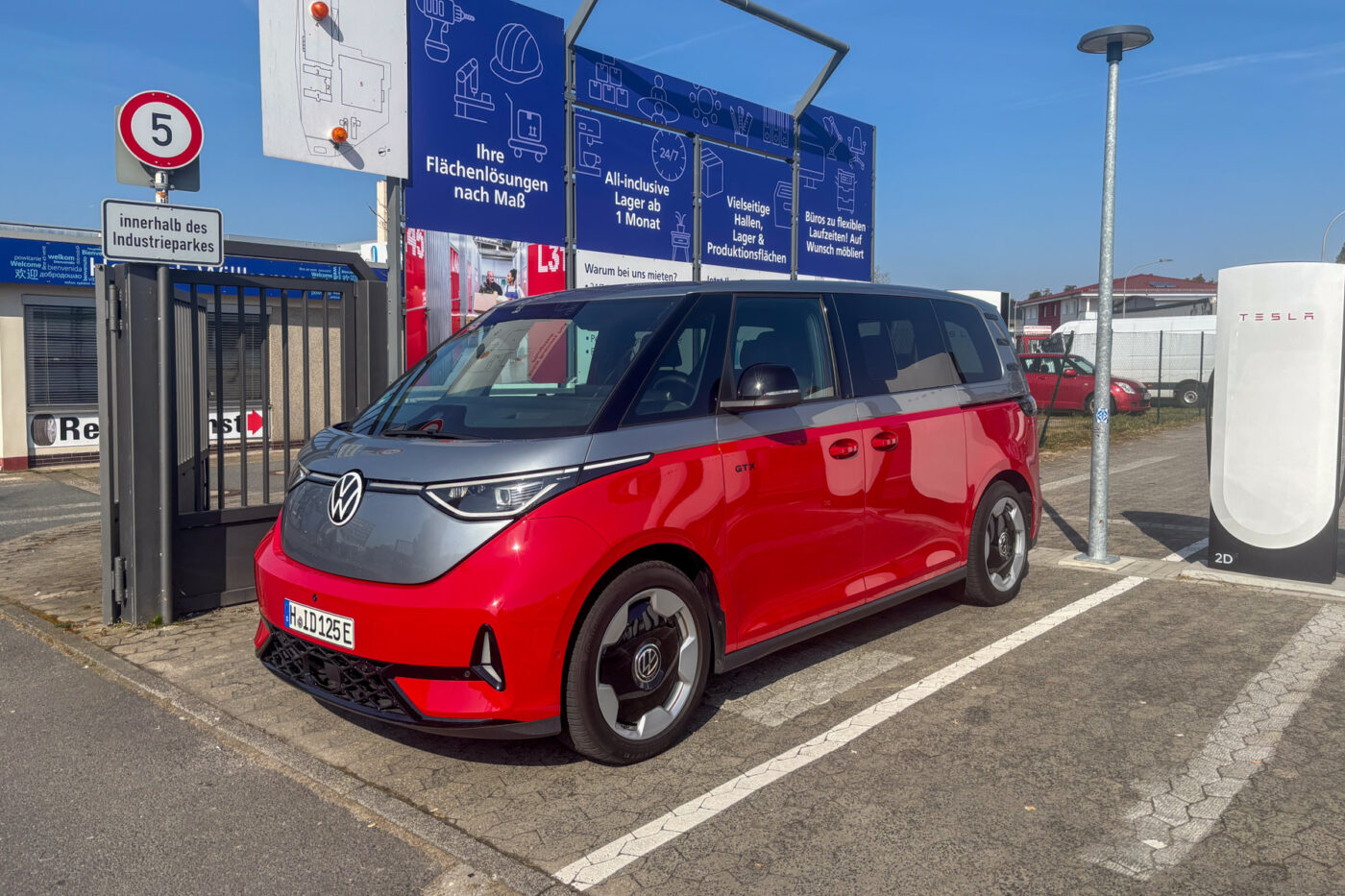
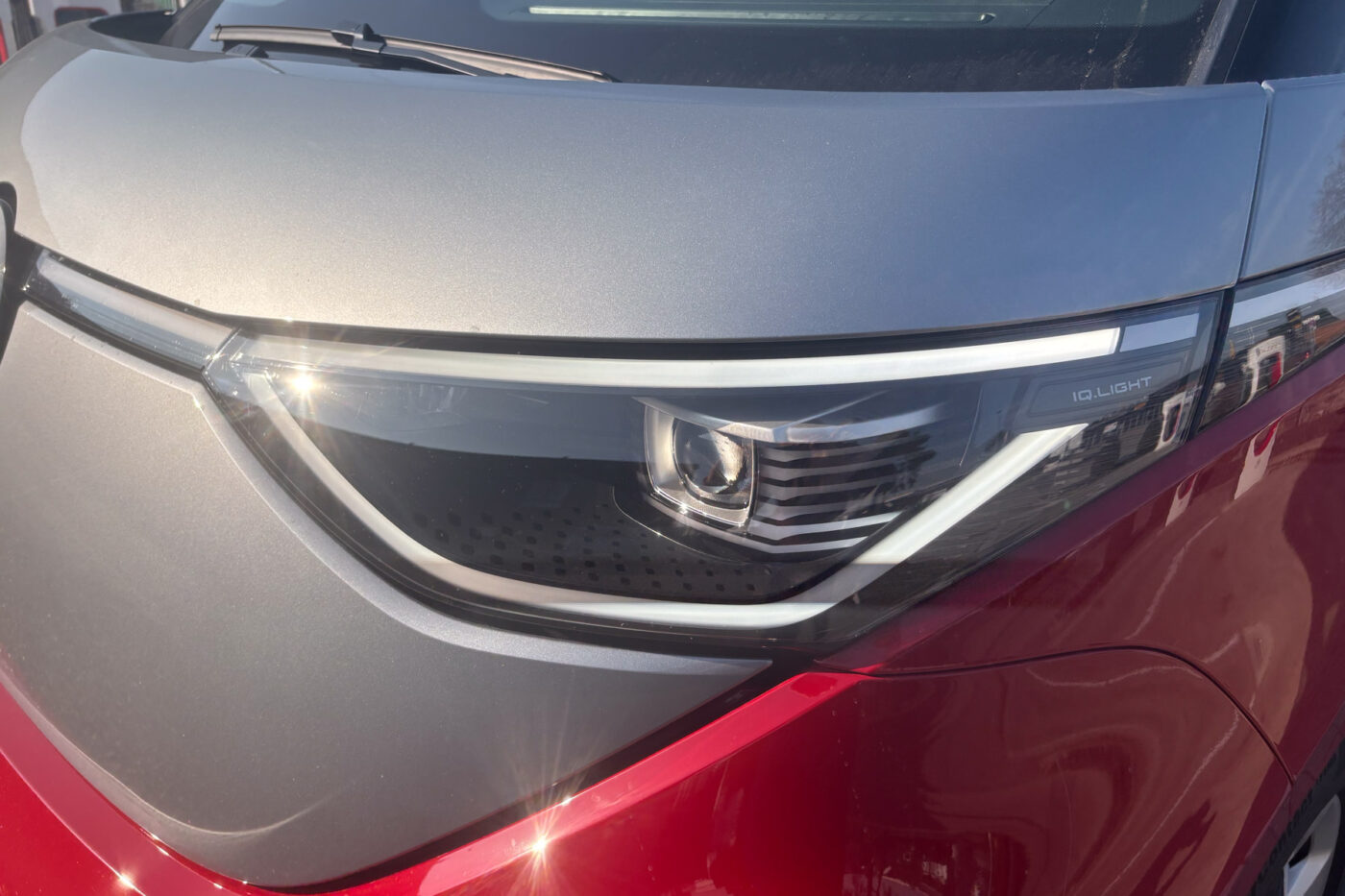
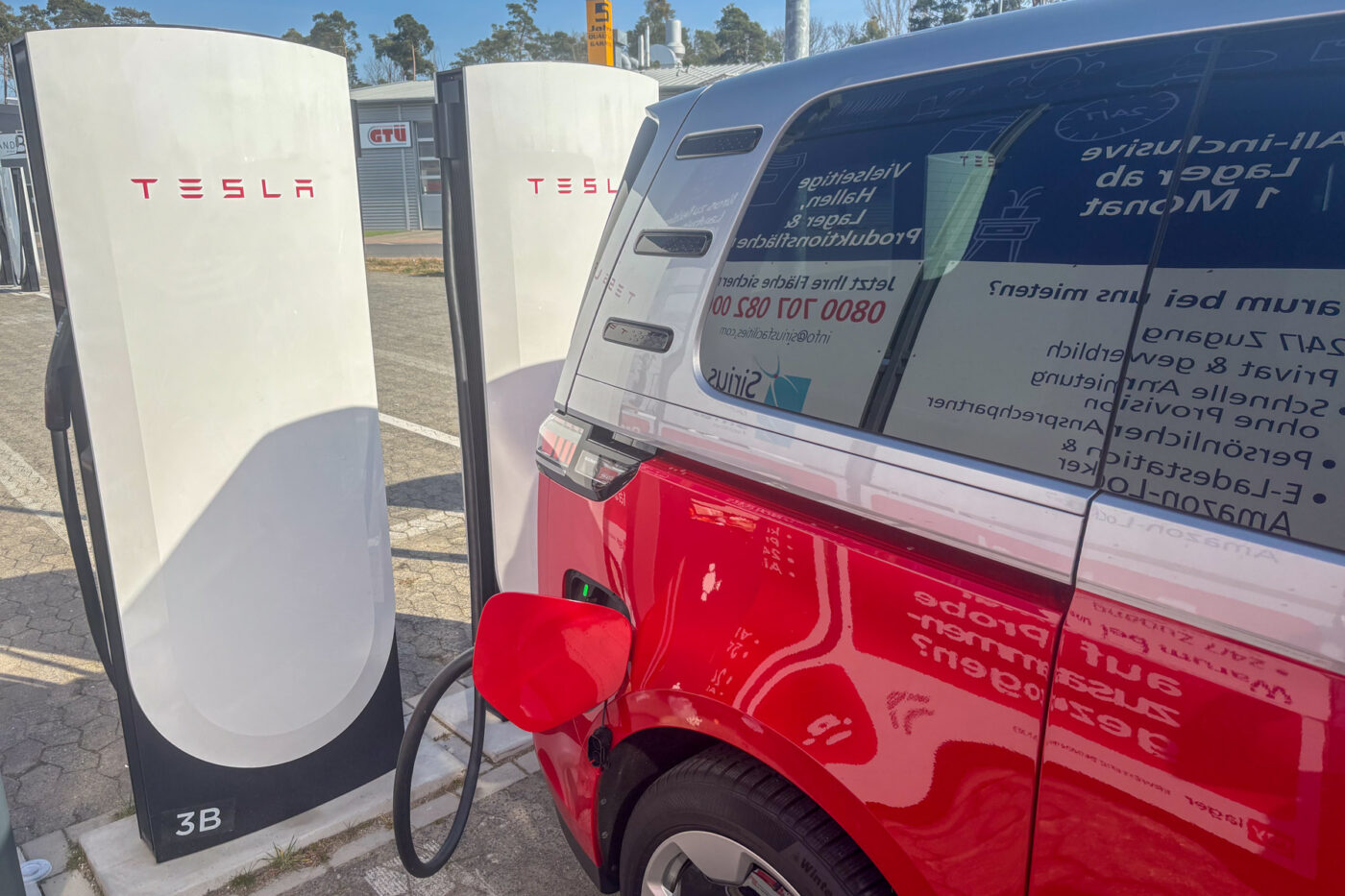
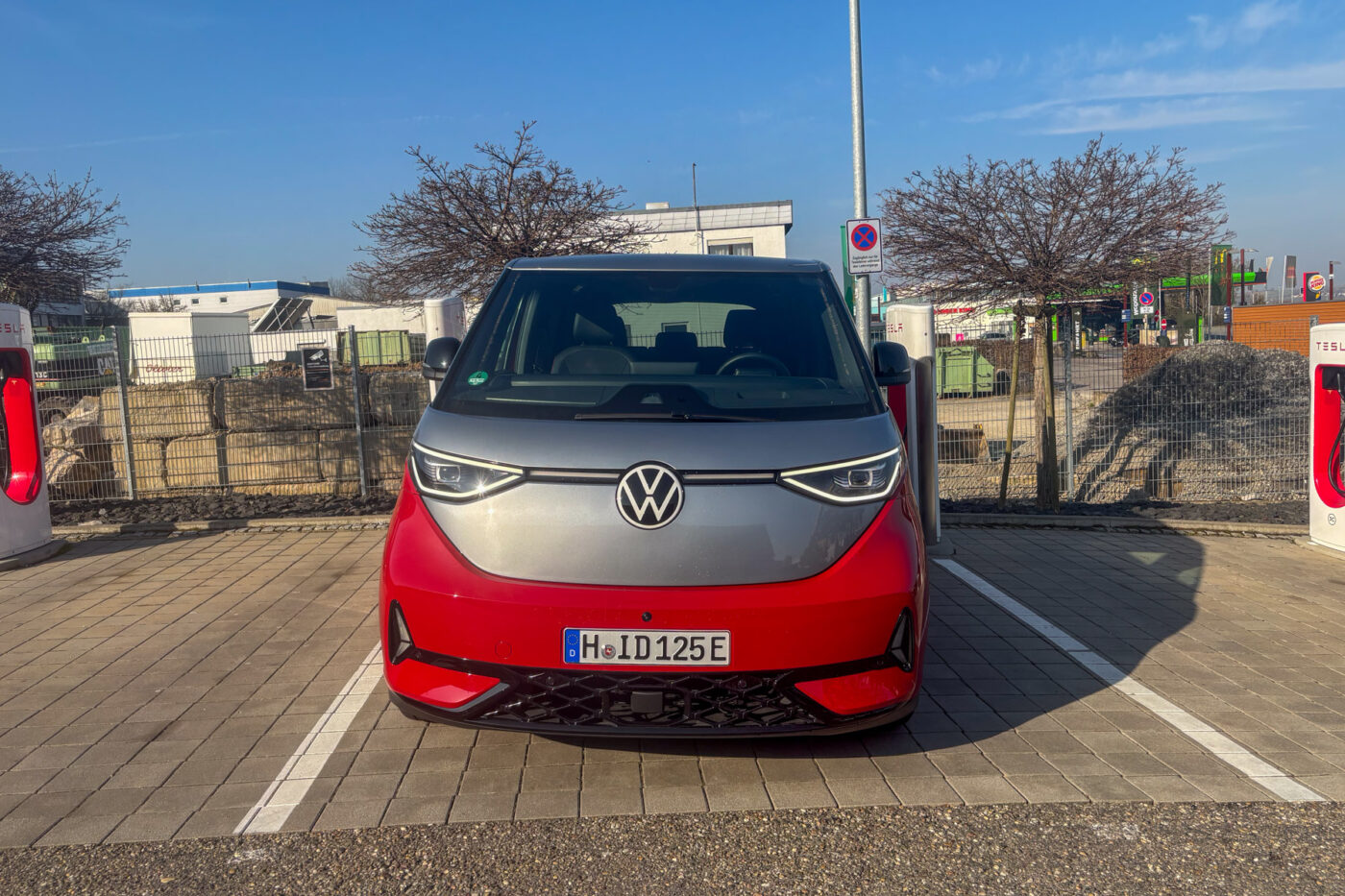
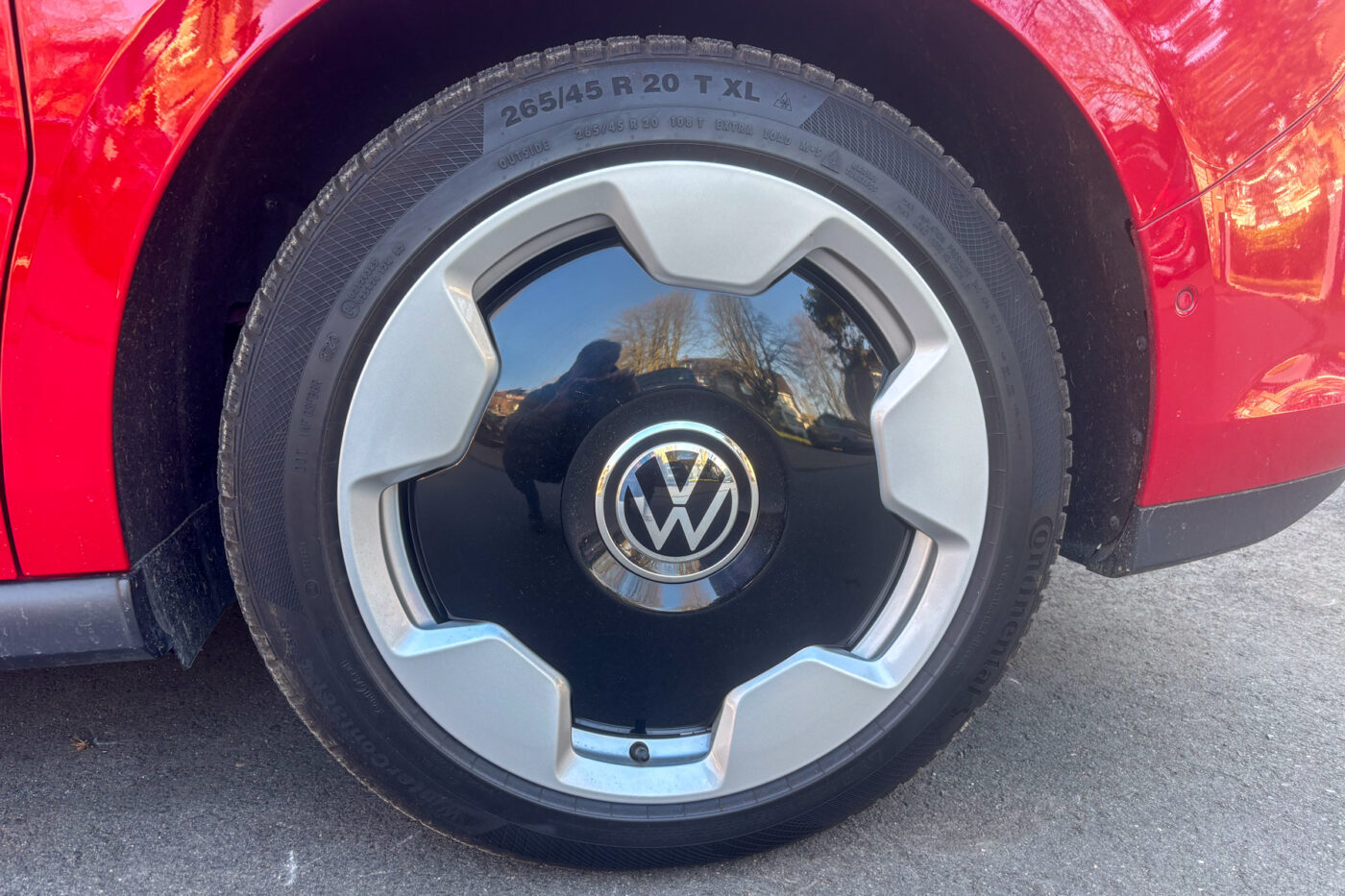
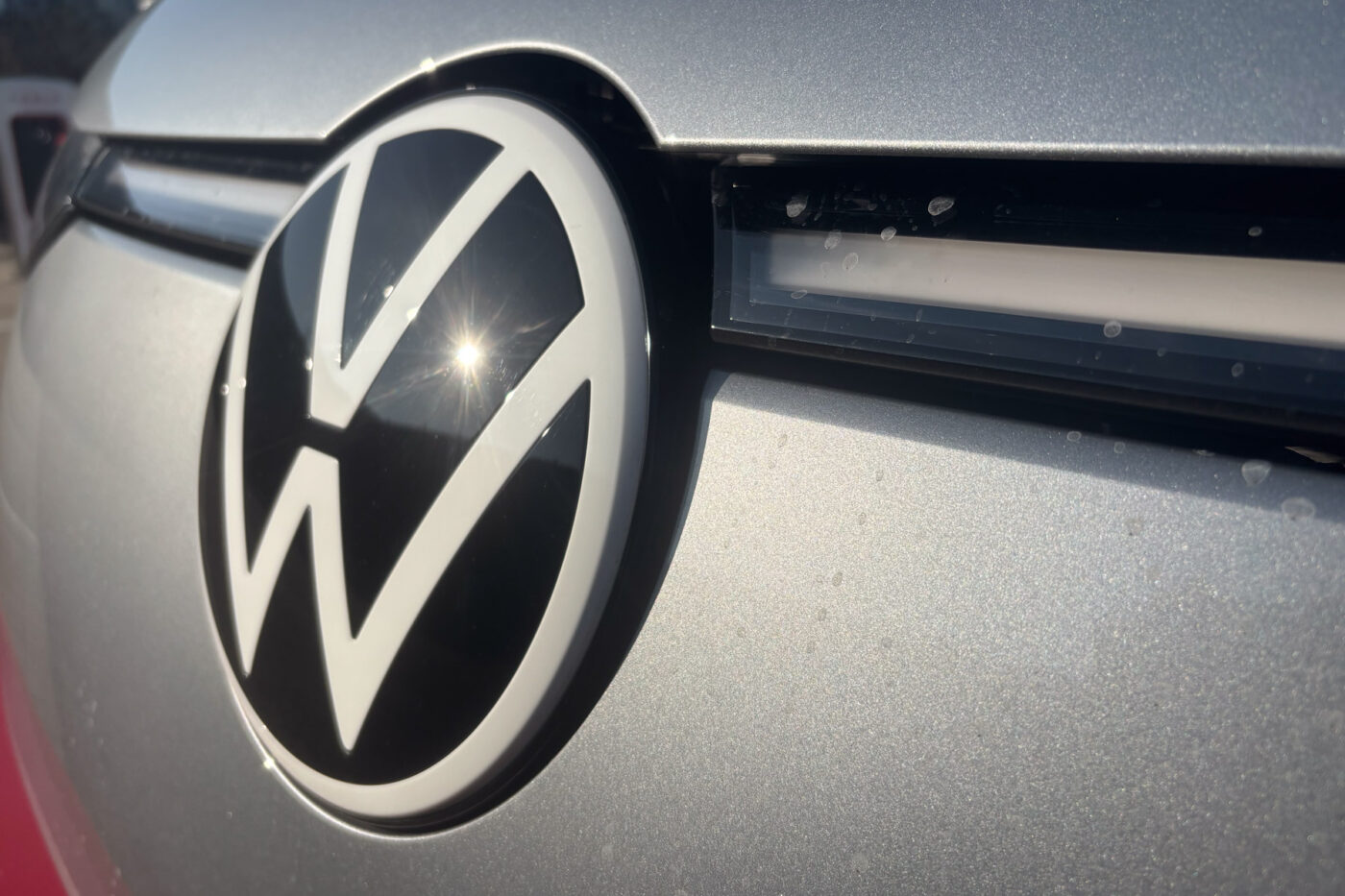
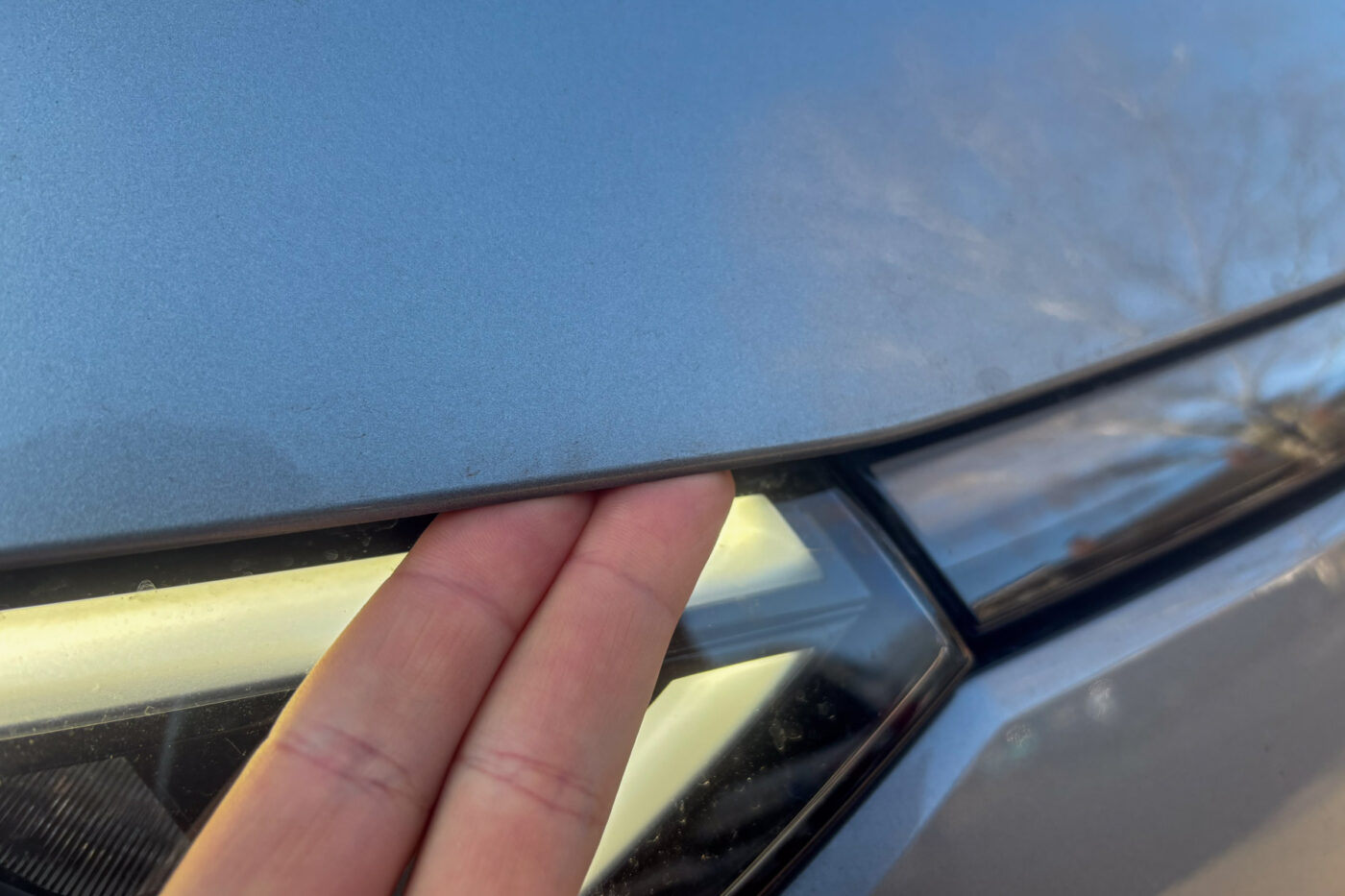
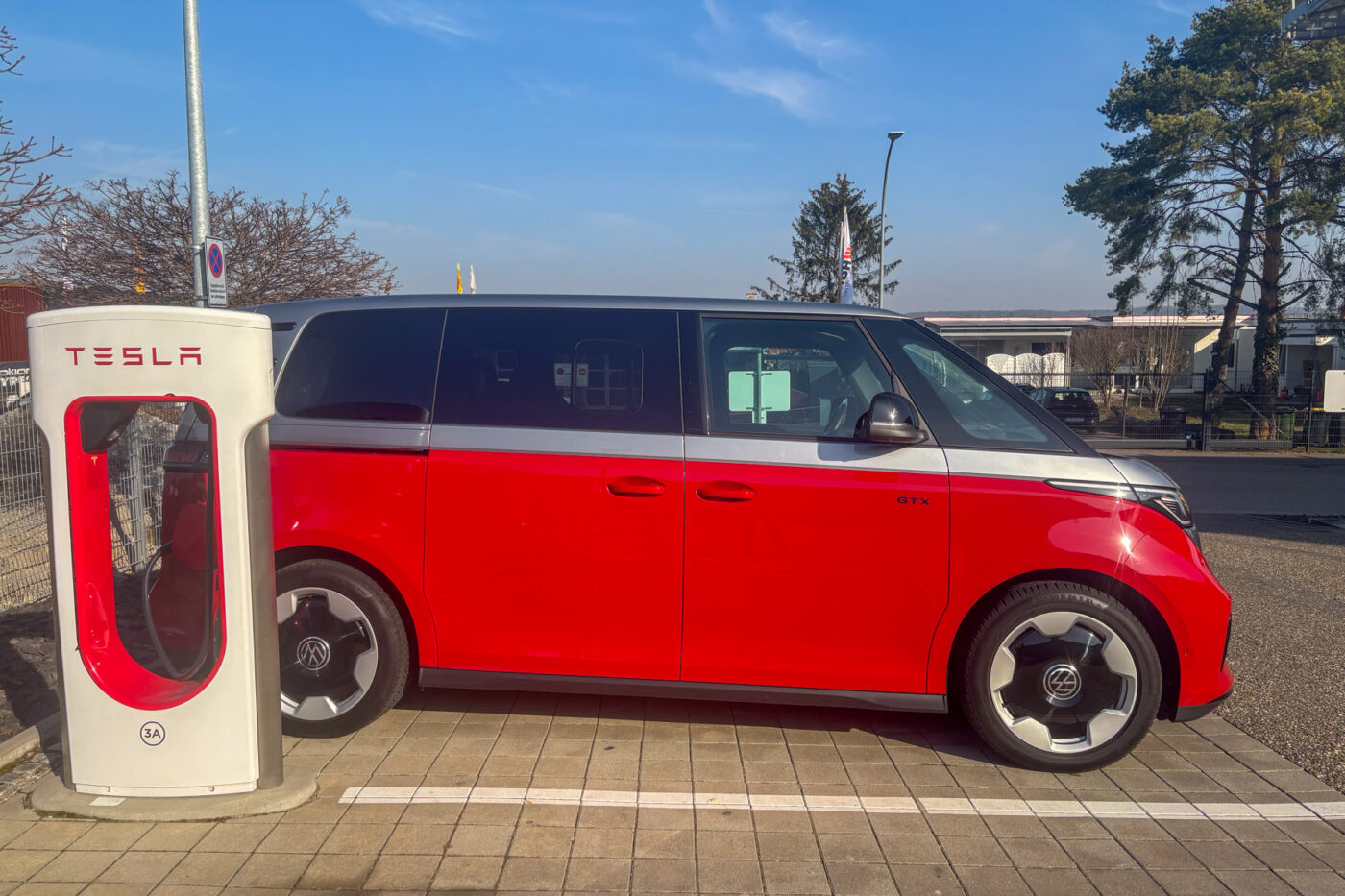
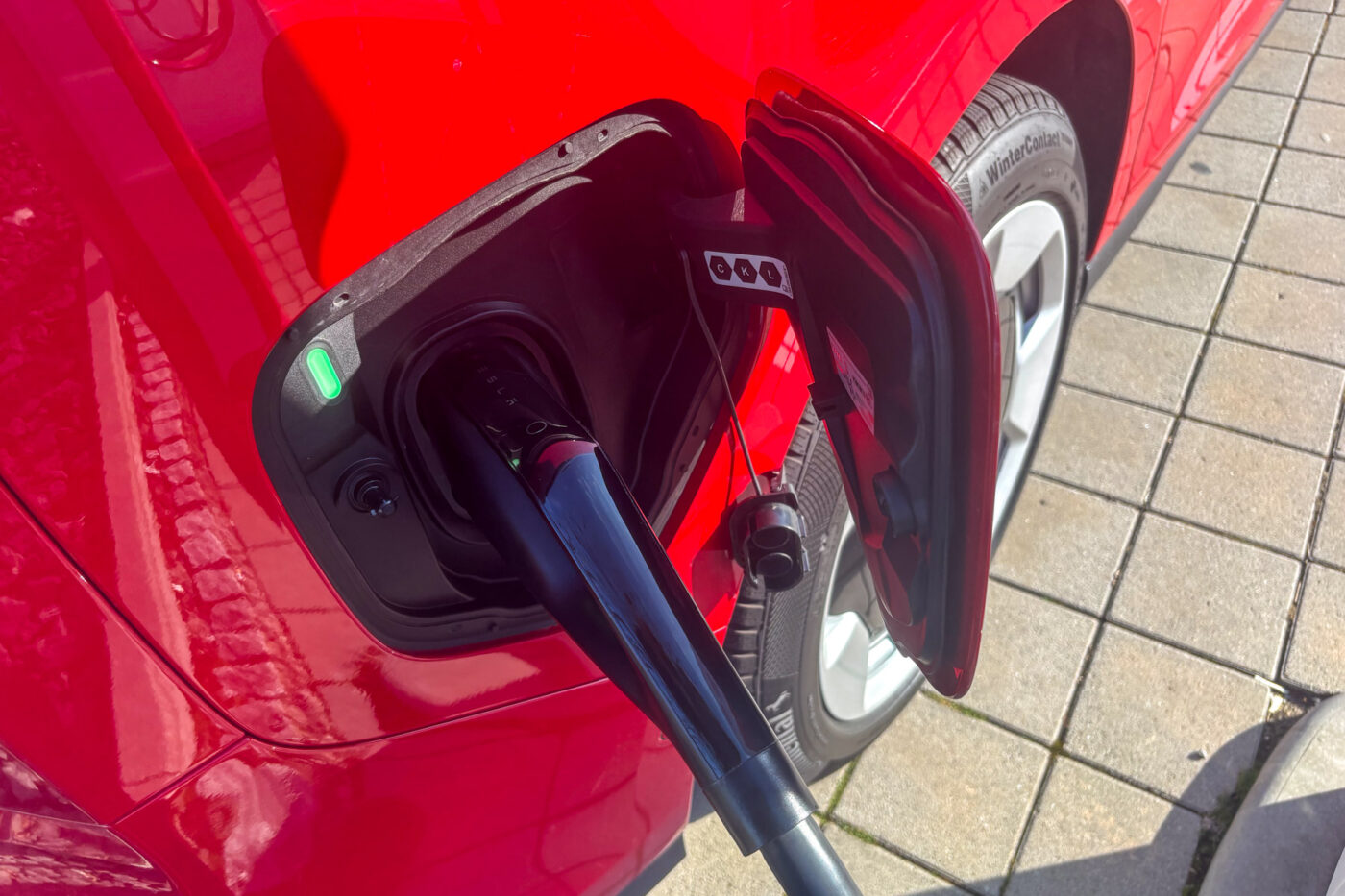
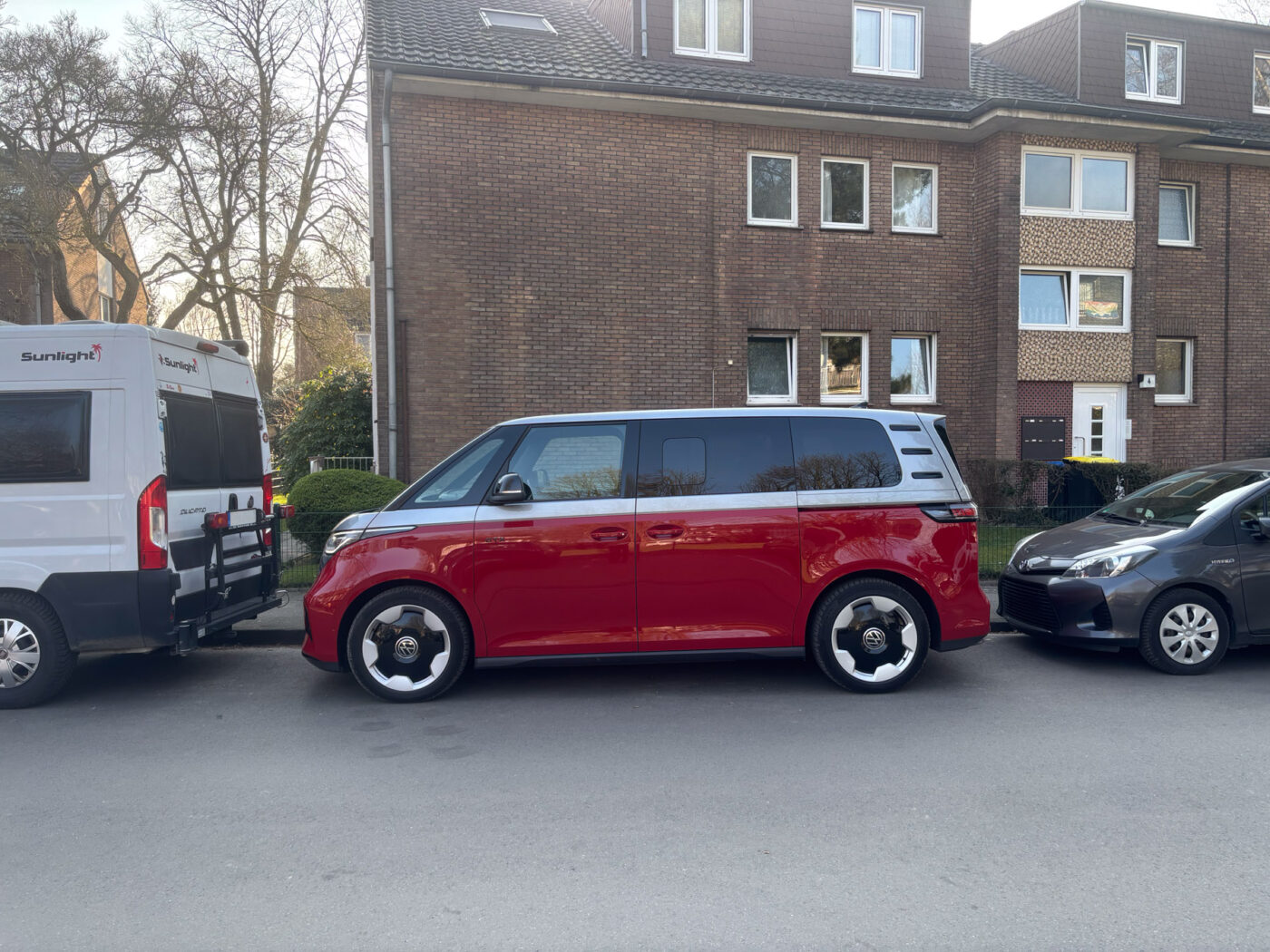
The ID. Buzz GTX drives surprisingly dynamically. In Sport mode, you wouldn’t think you were in a family van, given the good acceleration. And cornering can also be unusually brisk. However, the Hanover-built van doesn’t quite match the cornering behaviour of an ID.5 GTX with the same drive system, although, to be fair, it should be mentioned that the ID. Buzz GTX was fitted with 20-inch winter tyres and the ID.5 GTX tested some time ago was fitted with summer tyres.
The ID. Buzz GTX’s wide winter tyres (235/50 R20 at the front, 265/45 R20 at the rear) may also have played a certain role in energy consumption, but probably a subordinate one. Due to the aerodynamics, the most relevant factor for the ID. Buzz’s consumption is speed. With its steep and wide front end, the van itself is not exactlystreamlined, while the completely vertical rear section creates a large low-pressure zone in the air and generates a lot of vortices – both of which ‘slow down’ the ID. Buzz and increases drag. Small details such as the relatively strongly overlapping edge on the front flap (e.g. for the wiper water) certainly don’t help to reduce the drag coefficient either.
Energy consumption depends heavily on speed
During the test, the average consumption over 931 kilometres was 25.5 kWh/100 km. Certain electric SUVs of this length might even have reached an average of below 20 kW/100 km with our driving style – in any case, it would have been at least 20-22 kWh/100 km. However, it must also be said that of the 931 test kilometres, around 750 kilometres were driven on motorways – where the ID. Buzz suffers particularly due its aerodynamics. If you set the cruise control to 100 kph there, consumption values of 22-23 kWh/100 km are quite possible. At a cruising speed of 130 kph, however, you should calculate with up to 27 kWh/100 km, depending on the temperature – which reduces the displayed range to just under 300 kilometres. And if you calculate 70 per cent of this for the usual long-distance range from ten to 80 per cent charge level, only 205 kilometres remain – as a worst-case scenario, mind you. If you take a more leisurely approach, motorway ranges of 360 kilometres (or 250 kilometres as a 70 per cent value) are possible. And with this size of vehicle, that is again almost impressive. But if you drive the ID. Buzz GTX like a sports car, this is disproportionately reflected in the consumption and range values.
The fact that even the GTX can be quite economical is demonstrated on the country road. In Eco mode, the 80 kW asynchronous motor on the front axle is barely utilised, with the 210 kW rear motor taking over. This is the APP550, an in-house VW development with 545 Nm torque and permanent magnets in the rotor. Even the large van could be driven with a consumption of 17 kWh/100 km at single-digit plus degrees – making a range of 465 kilometres, in real terms and not according to WLTP. To compare, the standard consumption of the GTX with a short wheelbase is between 20.4 and 21.6 kWh/100 km.
We were also able to narrowly beat another test criterion with the ID. Buzz GTX: The data sheet for this battery variant states a maximum DC charging capacity of 185 kW and 26 minutes for charging from ten to 80 per cent. We only needed 25 minutes (twice) with the test car and saw up to 186 kW on the display. This is a very good value for a 400-volt system with 79 kWh net. The ID. Buzz doesn’t quite come close to the 800-volt system in the Kia EV6, but it leaves other 400-volt electric vehicles behind over large parts of the charging curve.
What is particularly remarkable is that we achieved the 25 minutes once under almost optimal conditions at an outside temperature of almost 20 degrees, but the other time at temperatures around the freezing point. The battery preconditioning works, and the 25/26 minutes charging time can be achieved reliably and reproducibly under a wide range of conditions, although we were unable to test the behaviour at higher outside temperatures during our test in March.
Nevertheless, the (rightly) much-maligned VW software stands out here with its very pleasant feature: With just a few clicks, the system transparently displays the charging power that can be used to charge at the current charge level and battery temperature, what would be possible at the optimum battery temperature and – crucially – how long it will take to reach this optimum temperature. This makes it easy and precise to decide exactly when to activate preconditioning manually. Or you can leave it to the software itself, which automatically preheats or cools the battery appropriately during scheduled charging stops. The suggested charging stops are also sensible and usable. Fortunately, the days when the VW navigation system scheduled the switched-off 20 kW charger at an Ikea shop on a Sunday are now over. With the current software generation, many of the MEB models from the VW Group now make sense if you are looking for a reliable electric car that is suitable for everyday use.
Where you can ask the ‘sense or nonsense’ question again is with the body concept itself. As mentioned, the 4.71 metre long standard version is only available as a five-seater. With this length, the ID. Buzz is even slightly shorter than the global electric bestseller, the Tesla Model Y. While the Tesla is something of a benchmark for space utilisation in the mid-size electric SUV segment (and actually also for combustion SUVs of this size), the ID. Buzz only laughs quietly at the space available in the Model Y. Yes, the ID. Buzz is wider (1.99 metres without and 2.21 metres with exterior mirrors) than the Tesla (1.98/2.13 metres), but not by much. And yet all five seats are similarly roomy (we’ll leave out the additional interior height of the van for the sake of comparison), with a slight bias in favour of the ID. Buzz with even more space – the model is also available as a six-seater for an additional 1,261 euros. So why drive a van if it doesn’t offer much more than an SUV – and isn’t even available as a seven-seater with this wheelbase?
The big difference lies in the boot, even if there is enough space for five people. The tesla already points with a loading width of 95 centimetres between the axles and a loading length of up to 1.10 metres to the rear seat backrests. However, the ID. Buzz GTX can fully exploit the strength of the van body and offers just over 1.20 metres between the axles and 1.33 metres to the rear seat backrests. This results in a boot volume of 1,121 litres up to the upper edge of the rear seat backrests, and even more when loaded to roof height (with partition grille). And if the rear seats are removed, objects up to 2.32 metres long and 1.20 metres wide can be loaded. But even the standard boot should be more than sufficient. While a typical week’s shopping, including crates of drinks, fills the boot of my Model Y well, the ID. Buzz would fit the same amount of shopping without even the slightest problem.
Highest towing capacity of all MEB models
The ID. Buzz GTX with the short wheelbase has a towing capacity of 1,800 kilograms on a twelve per cent gradient; with a long wheelbase, it is still 1,600 kilograms. The ID. Buzz Pro can only tow 1,200 kilograms, while the long-wheelbase version with rear-wheel drive can only tow one tonne. The ID. Buzz GTX not only outweighs all other MEB models with its 1,800 kilograms, but also the Model Y, which has just been used for comparison with 1.6 tonnes. Unfortunately, we cannot make any statement on the additional consumption with a trailer, as it always depends on the respective trailer body and its actual weight. However, it could be that the additional consumption is lower than with a flatter vehicle, as the trailer is travelling in the slipstream of the van, so to speak, and does not get the full airstream.
But one thing is clear: with a motorway range of 250 to 300 kilometres without a trailer and a payload of just 466 kilograms, the ID. Buzz GTX will not be a 1:1 replacement for a VW Multivan or Transporter that regularly travels long distances with large trailers – whether professionally for fitters (who are unlikely to opt for the GTX anyway, we’ll come to the cost chapter in a moment) or privately with the caravan to the Adriatic. However, it offers another option for short-distance use, which the ID. Buzz did not previously offer.
Regardless of the motorisation, travelling in the ID. Buzz is very pleasant. Despite the air resistance, it is really quiet, the chassis is well tuned, and the seats with their adjustable armrests are comfortable. However, the massage function is a little lax if you are looking for a point of criticism. The driving assistants, on the other hand, are again very good, and the somewhat unwieldily named ‘Travel Assist with swarm intelligence’ does its job extremely well. The automated lane changes after tapping the indicator are so quick that you can use the function not only on a completely empty motorway, but also when there is more traffic.
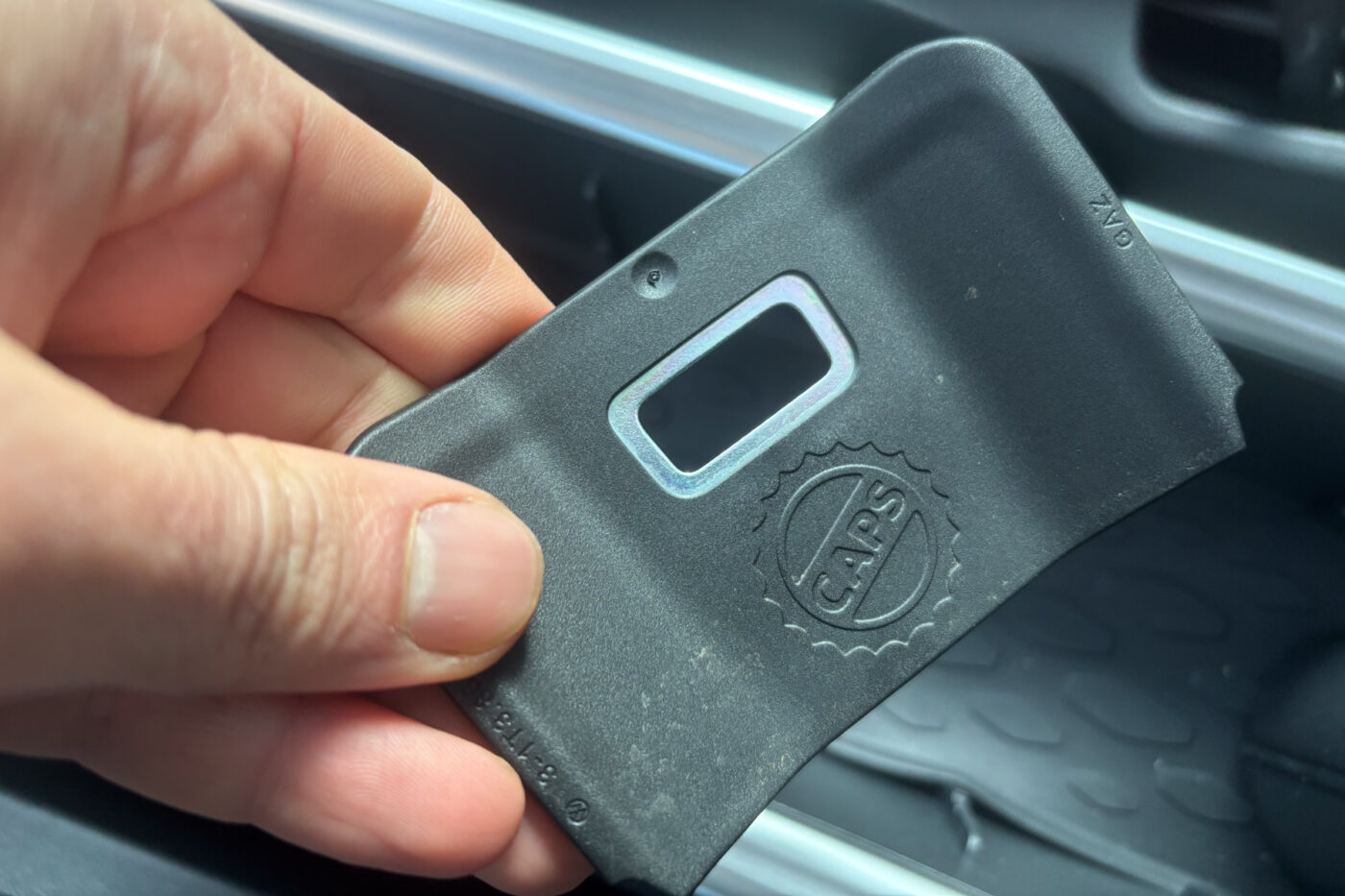
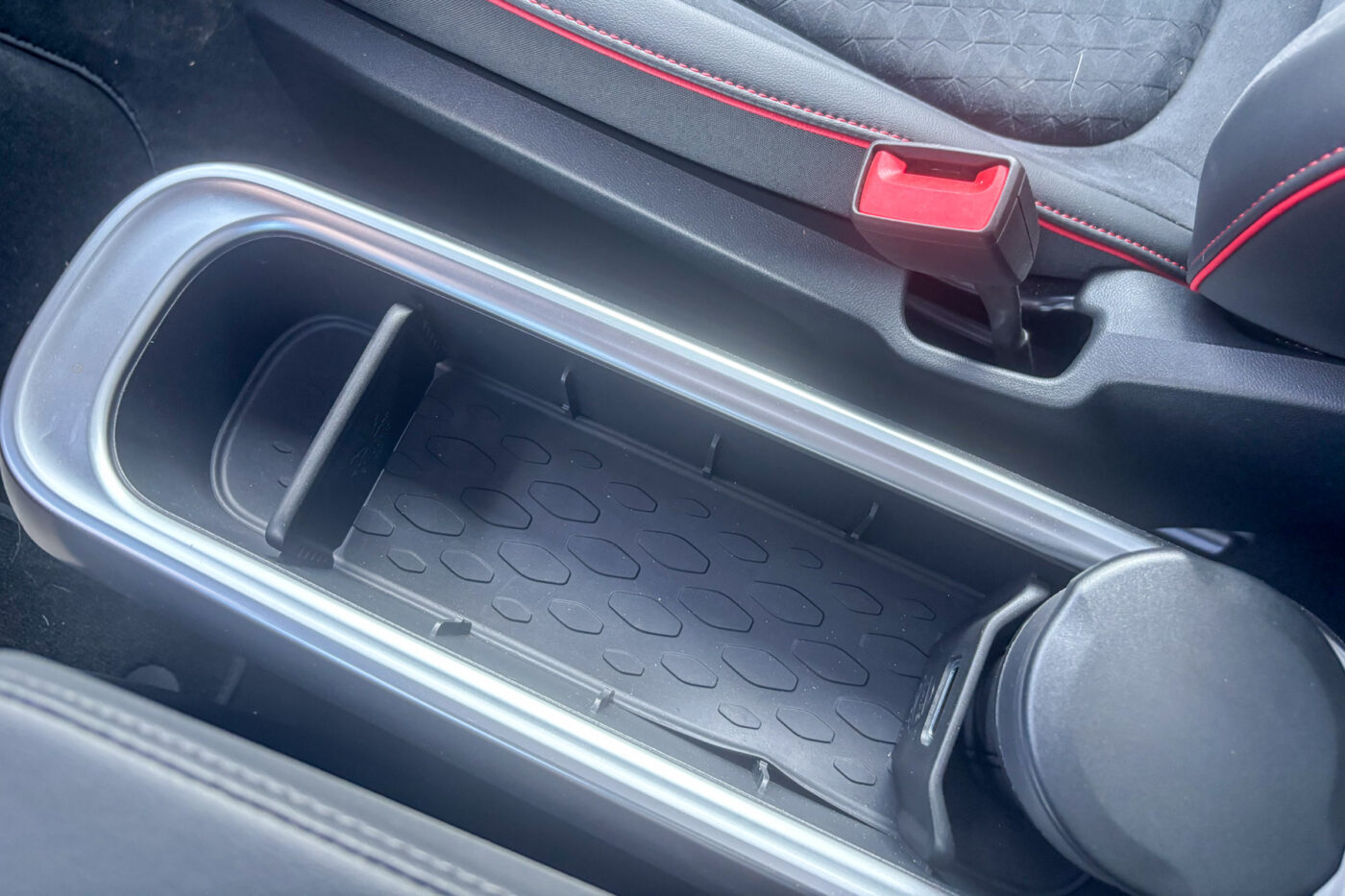
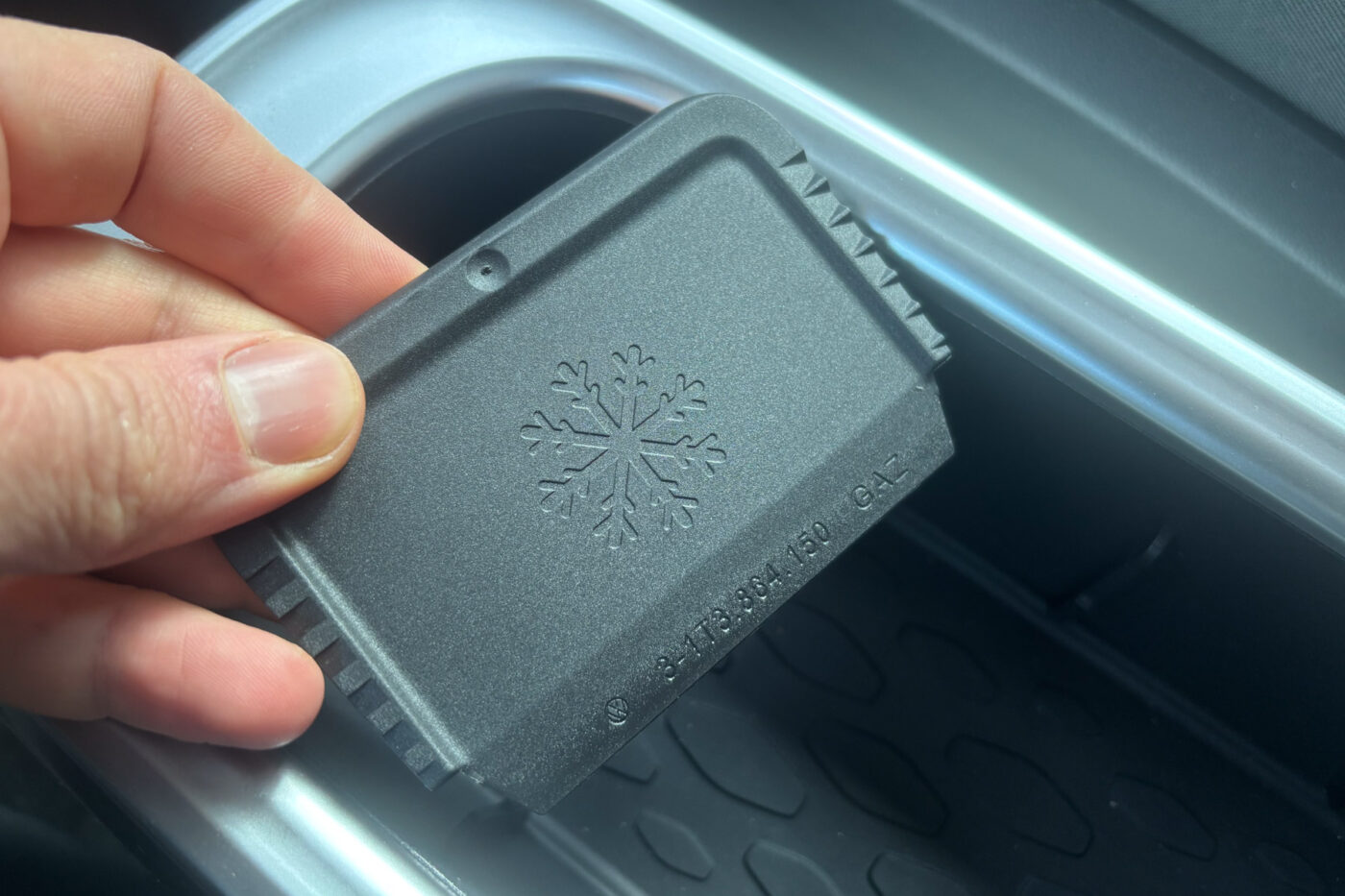
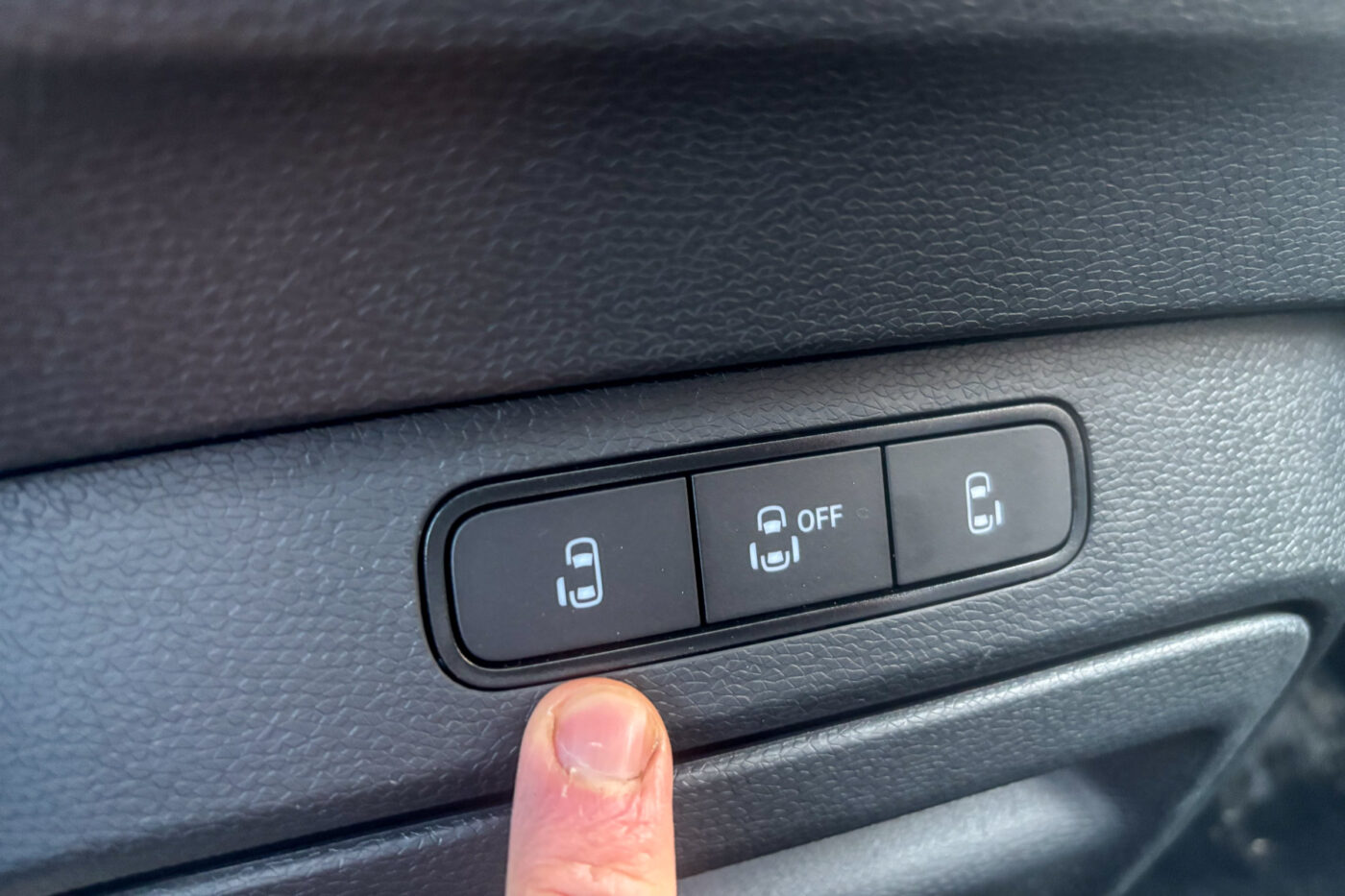
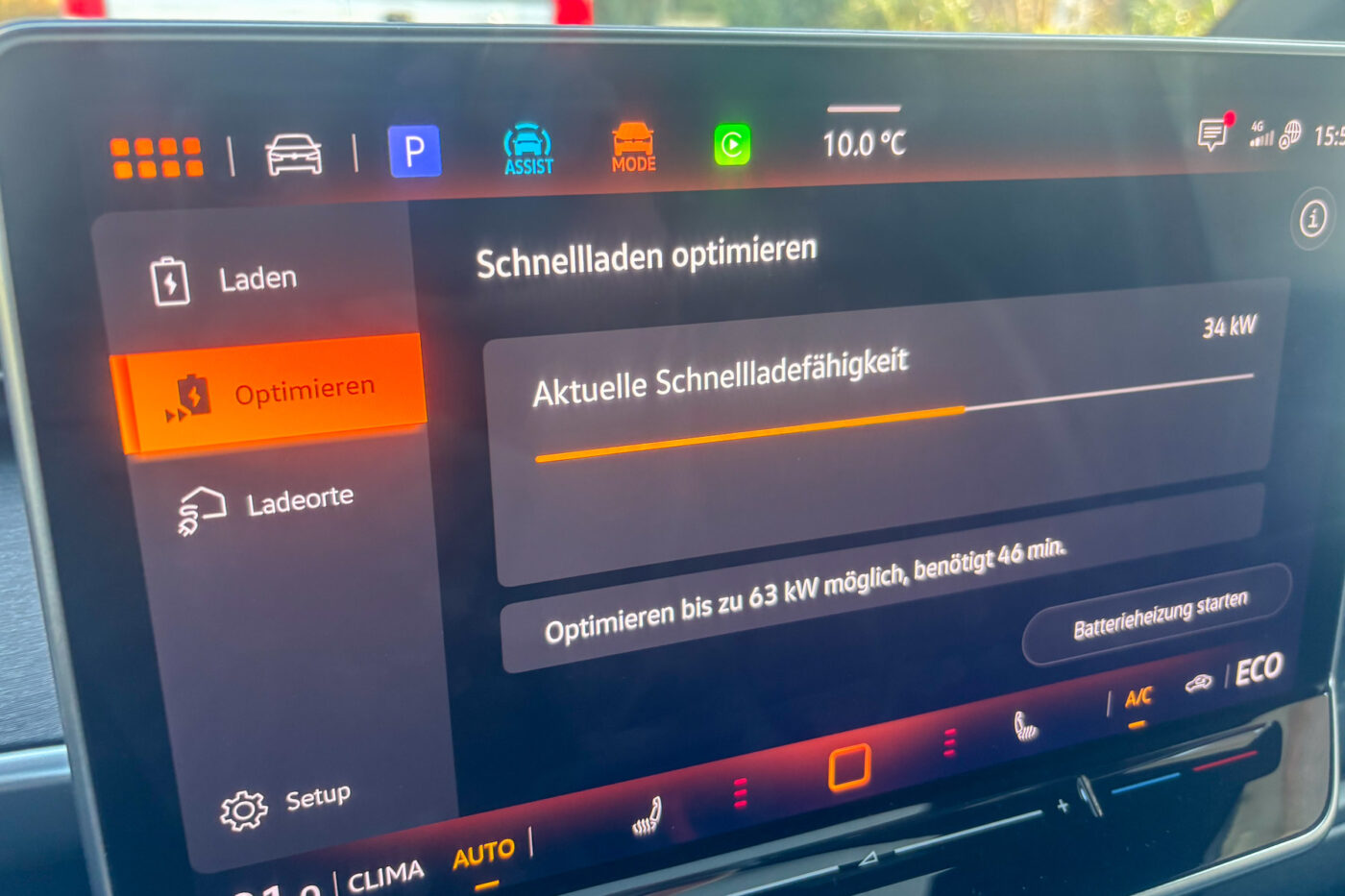
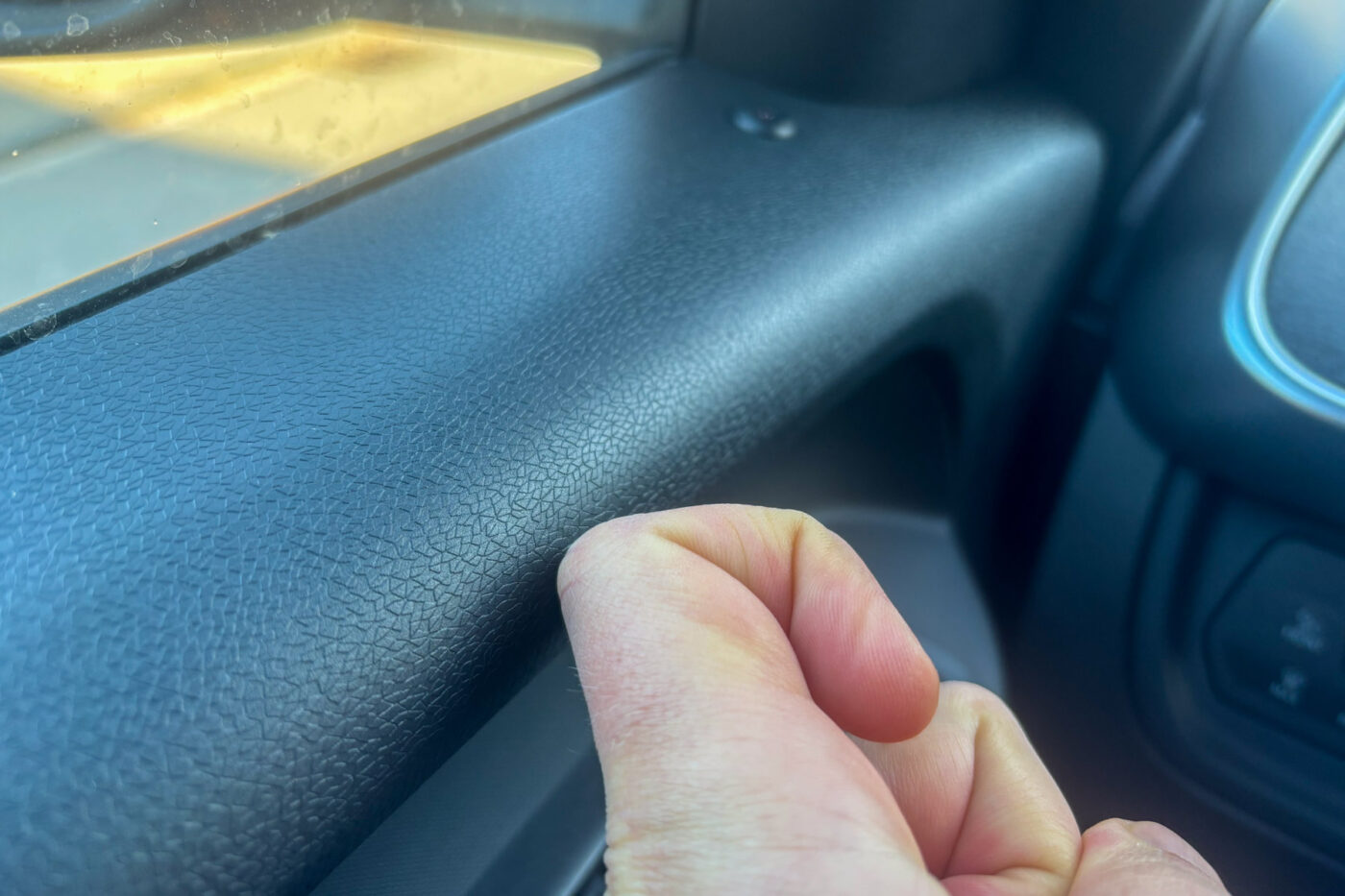
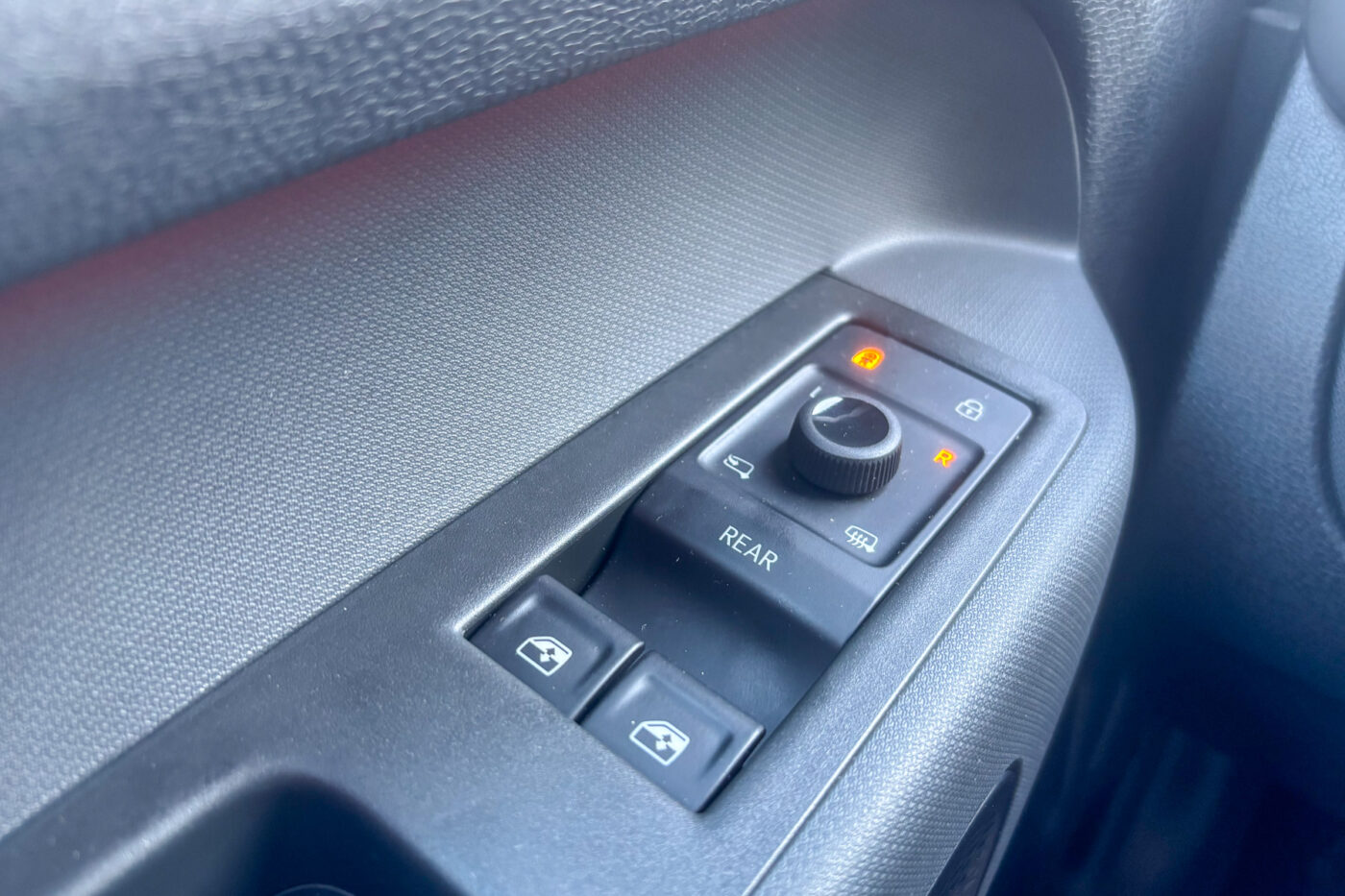
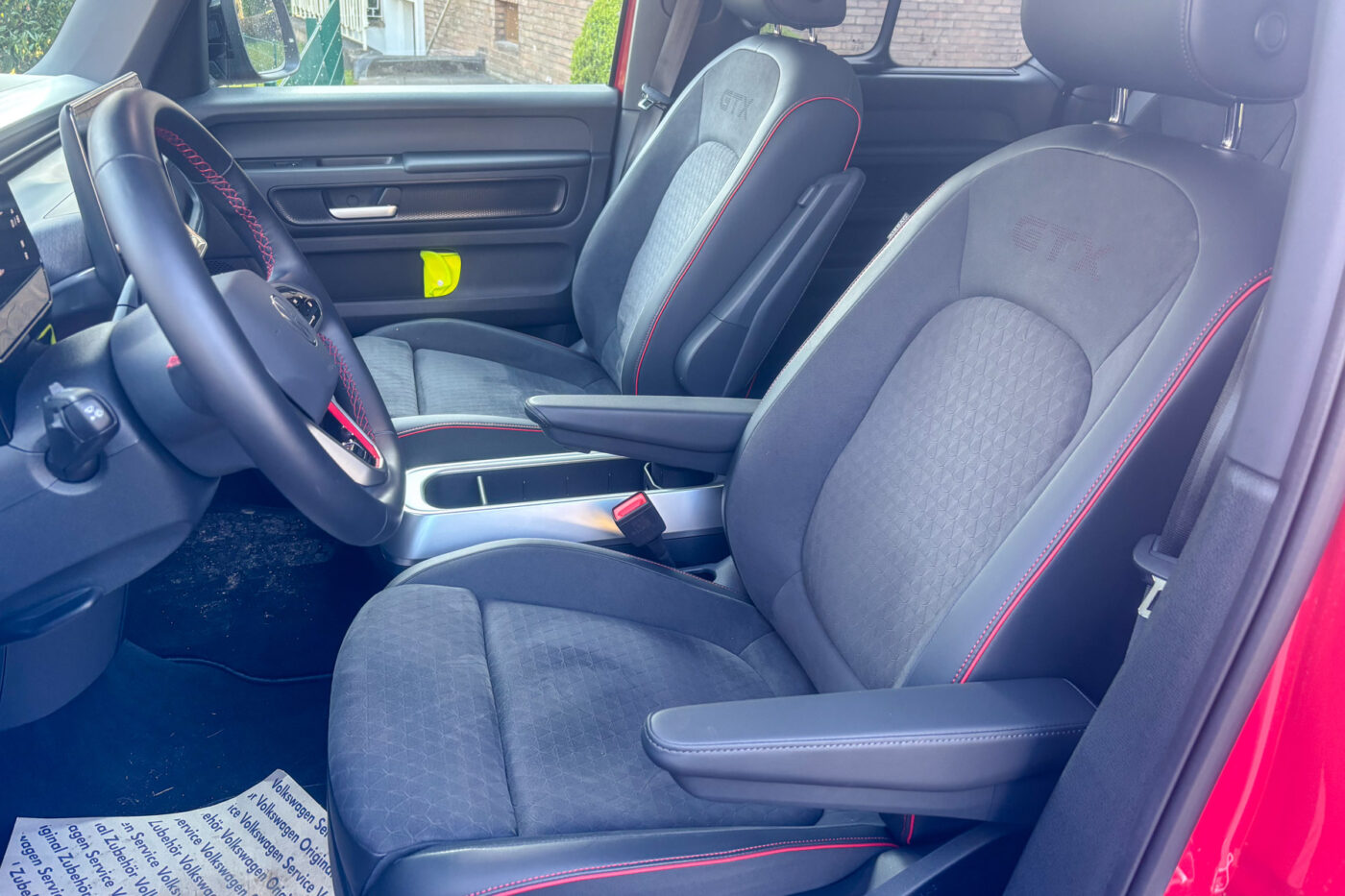
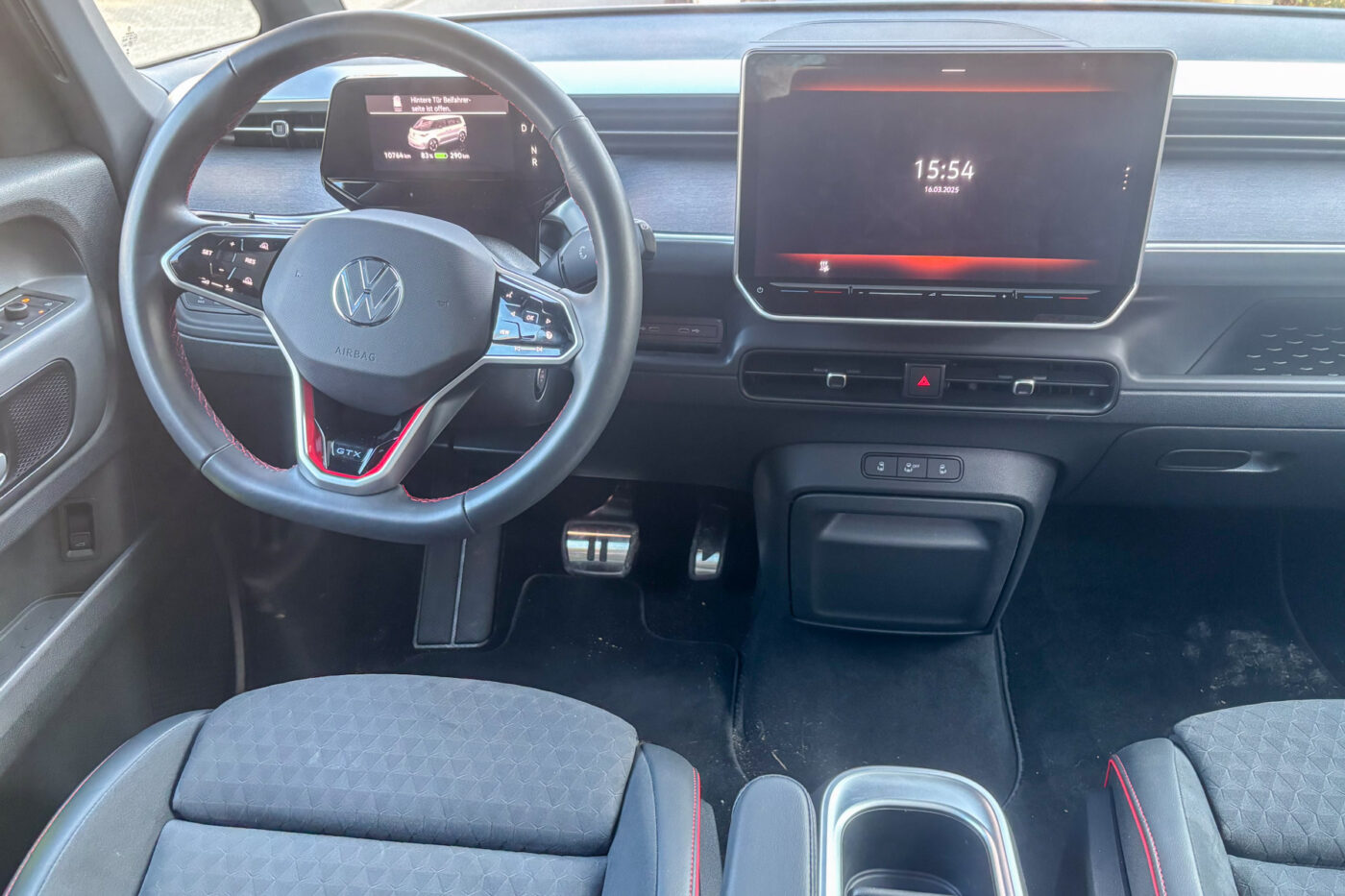
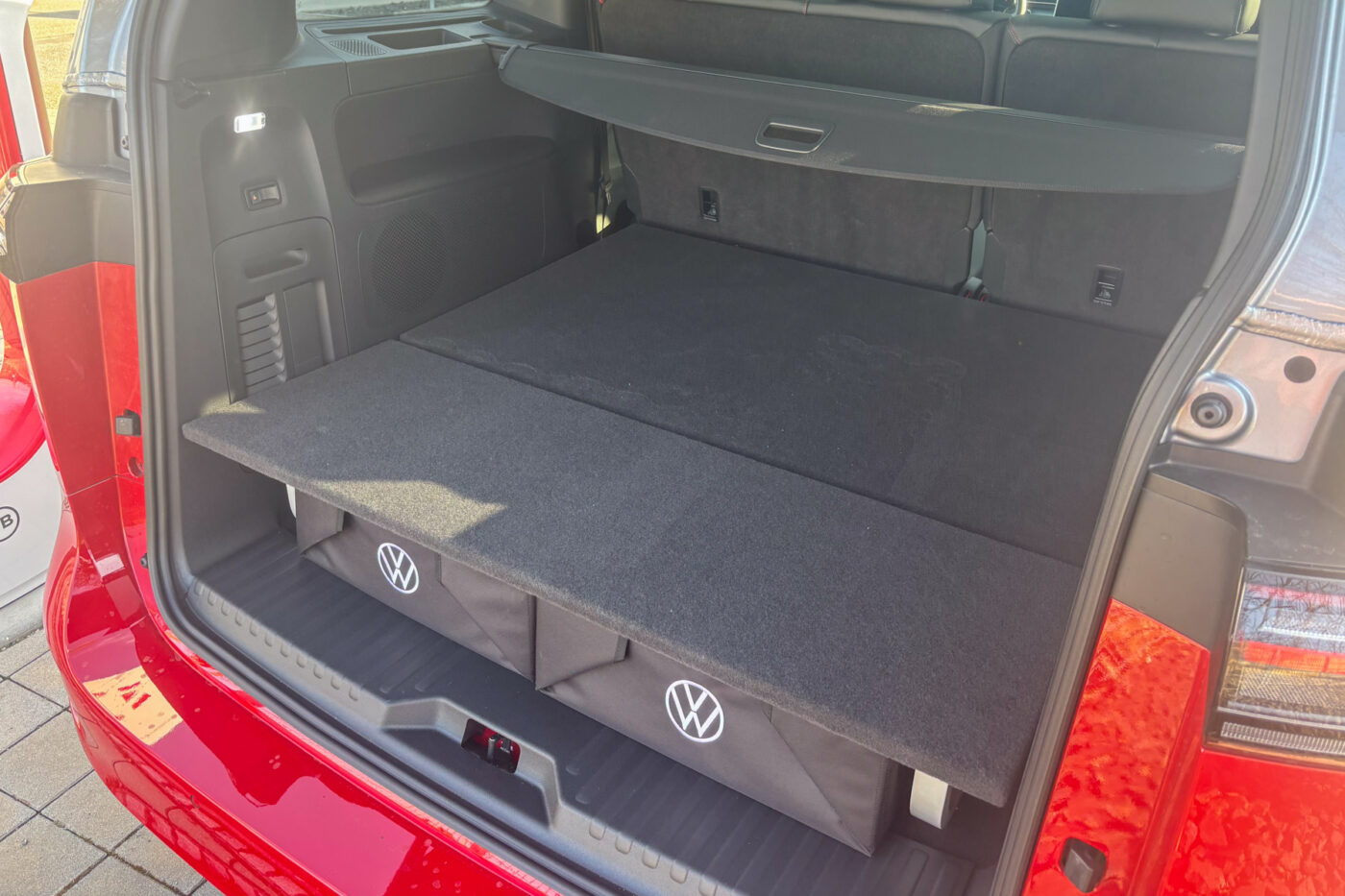
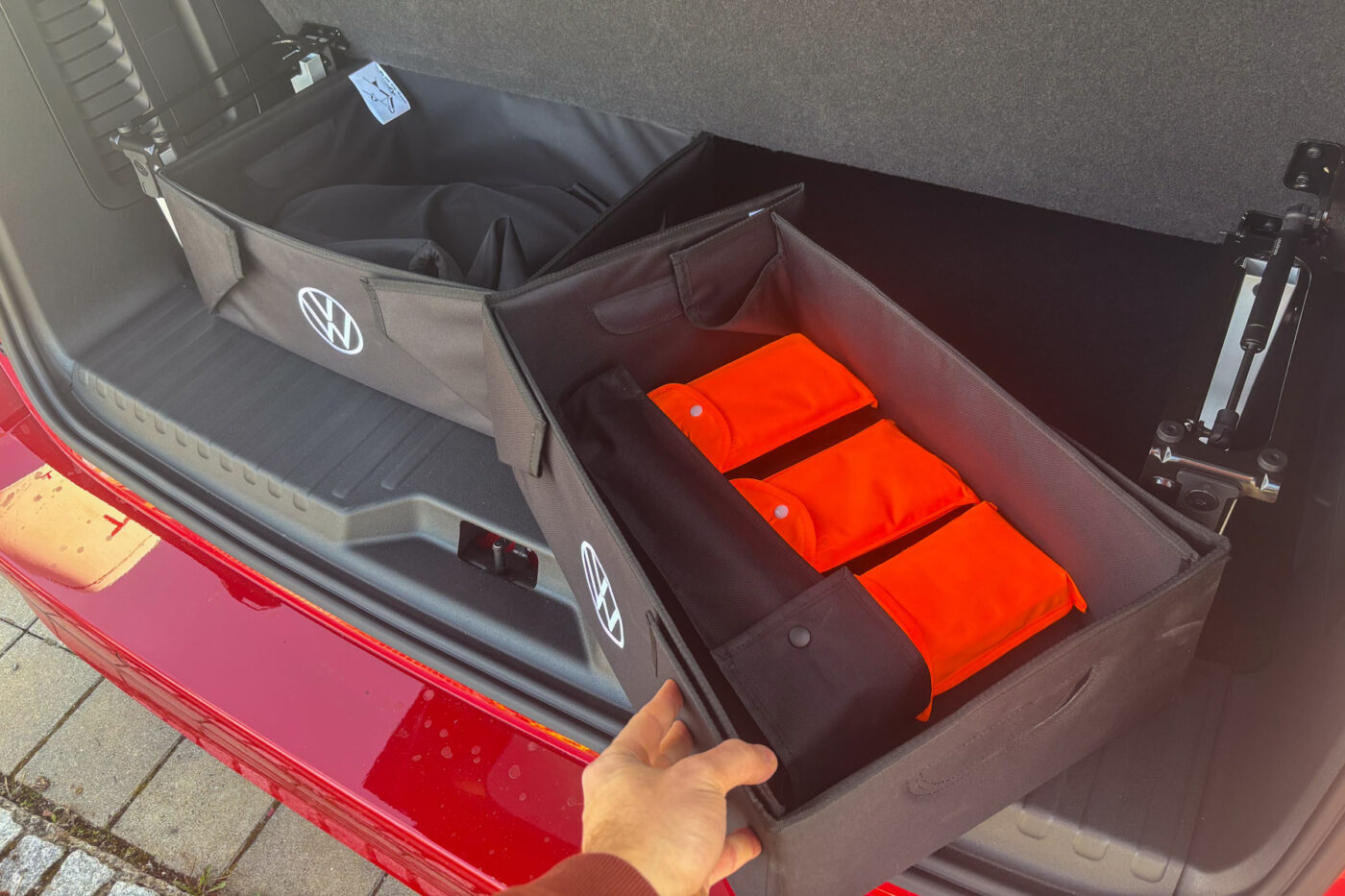
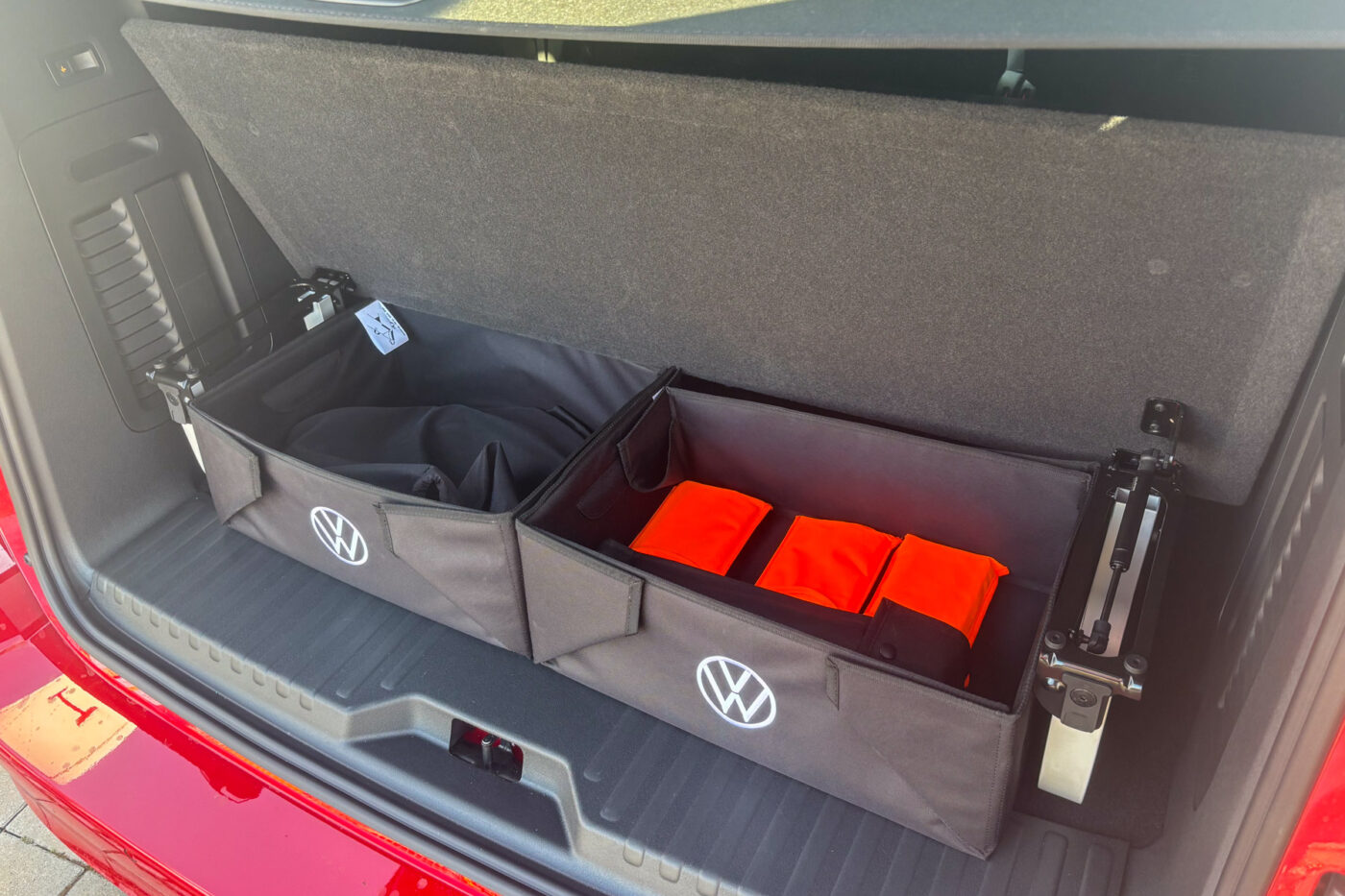
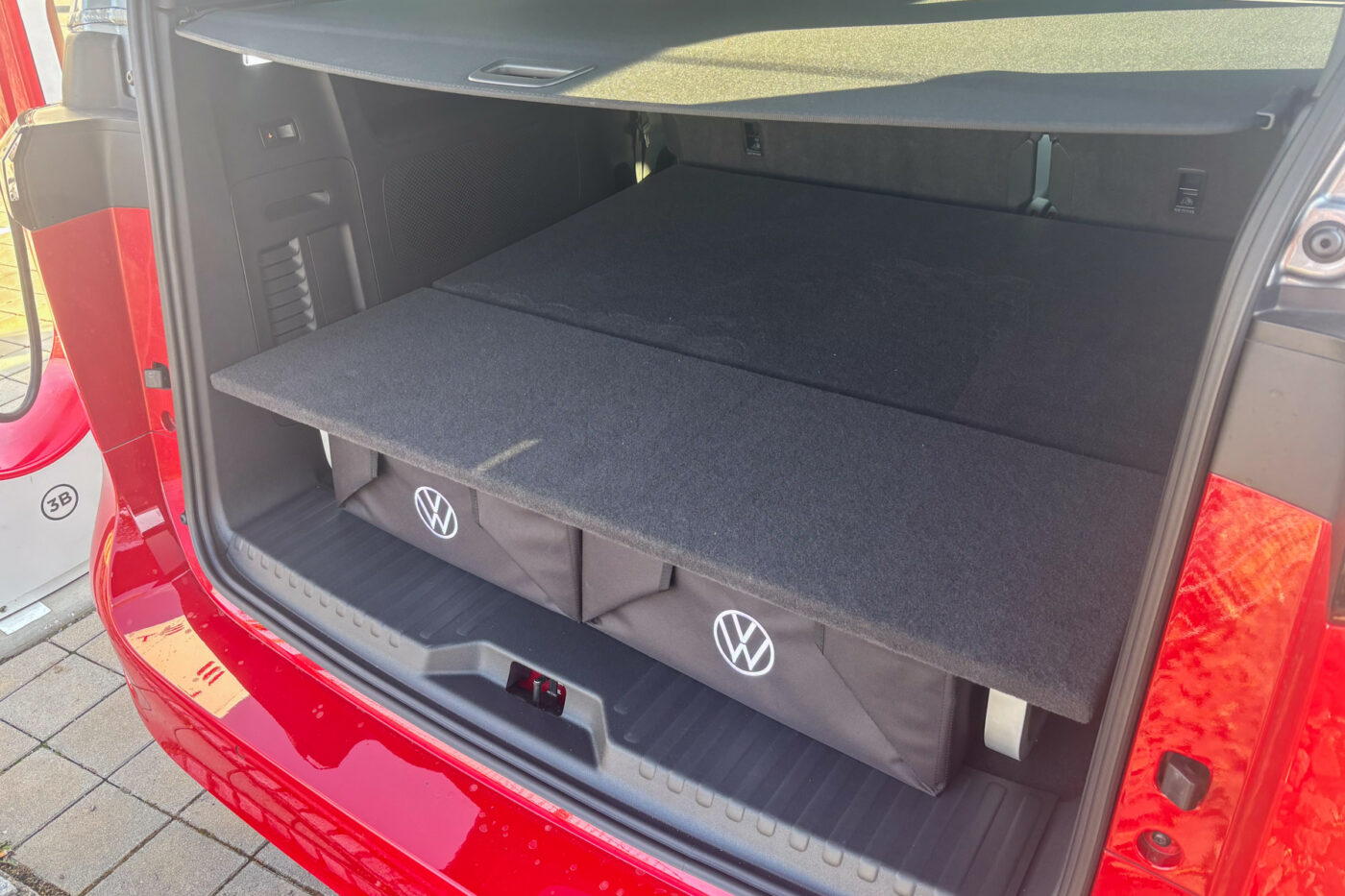
The parking assistant manoeuvres the ID. Buzz into spaces that I, without much practice with the car, would have ruled out. You underestimate the steering angle that the ID. Buzz is capable of, despite the additional electric motor between the front wheels. This makes parking and manoeuvring in and out of parking spaces extremely easy, even without automatic transmission, especially in comparison to the aforementioned Model Y, which is much more unwieldy with its steering angle.
So all’s well in the ID. Buzz, you might think? No, there are also more significant points of criticism than the intensity of the massage seats. The high-gloss black touch control panels on the steering wheel and the unlit touch sliders below the infotainment touchscreen are still very impractical. The same applies to the electric windows on the driver’s side, where there are only two levers and a touch switch for the front and rear – and yes, the ID. Buzz GTX (and other versions) can be ordered with electrically opening and closing sliding windows in the rear electric sliding doors for an extra charge. But above all, the hard plastic in the doors and cockpit is just as inappropriate in the ID. Buzz as in other MEB models. With one difference: the short ID. Buzz GTX starts at prices from 73,101.70 euros, with extras, the test car scrapes the 90,000 euro mark. Hard plastic has no place in this price range.
The base price of just under 73,000 euros is already steep, no question about it. However, many of the things we have praised in this test cost extra. Starting with the colour, the ID. Buzz GTX is painted in a single colour of cherry red or candy white. VWCV charges €2,058.70 for the two-tone mono silver/cherry red paint finish. The ‘Design Package Plus’, which basically consists of a continuously insulated ‘Smart Glass’ panoramic roof, costs 2,100.35 euros. The ‘Assistance Package Plus’ with Travel Assist costs €2,243.15 extra, although there is also a simpler assistance aspect (adaptive cruise control and reversing camera) for €1,428 – such functions should be standard in a €70,000 car! The ‘Infotainment Package Plus’ also costs over €2,600 extra, the ‘Comfort Package Plus’ with various features from the 3-zone automatic air conditioning to the ID. Buzz Box as a sliding centre console (the dividers in the storage compartment have a dual function as an ice scraper or bottle opener, see gallery) through to heated windscreen washer nozzles and an automatically dimming interior mirror is listed in the catalogue at 1,082.85 euros. At 981.75 euros, the electrically unlockable trailer coupling costs surprisingly little, while the heat pump is relatively expensive at 1,047.20 euros. Also worth mentioning is the ‘Open & Close Plus’ package, which includes the electric tailgate, electric sliding doors including the electric sliding windows and the keyless locking system for an impressive €2,915.50.
Conclusion
A van that is based on a car platform and is almost comparable to SUV models in some respects – you can certainly ask the question of whether it makes sense. Especially when it comes to a 250 kW all-wheel drive – but it is the sporty all-wheel drive version with its high towing capacity that offers the highest utility value.
So who is the ID. Buzz GTX for? For families with two or three older children, for example, if you are travelling with more luggage. Or you have a large family dog that would take up the whole boot in an SUV – in the ID. Buzz you can separate off a section with a grille or dog box and still have more cargo space than in an SUV without a dog. The six-seater is also ideal as a parent taxi for the football team. And if the horse has to be driven to a tournament in the area, the towing capacity of the GTX is indispensable – you won’t get far with the 1,200 kilograms of the rear-wheel drive vehicle.
As you can see, you have to construct a case where the ID. Buzz GTX is unavoidable. More often it will be that you simply want the car – from an emotional point of view. Because of its performance. Because of the design. Or both. You just need to have enough money to spare, because the GTX pleasure of the ID. Buzz is, unfortunately, not cheap.


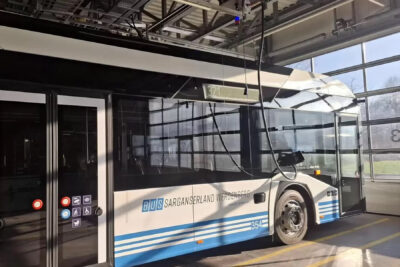

1 Comment